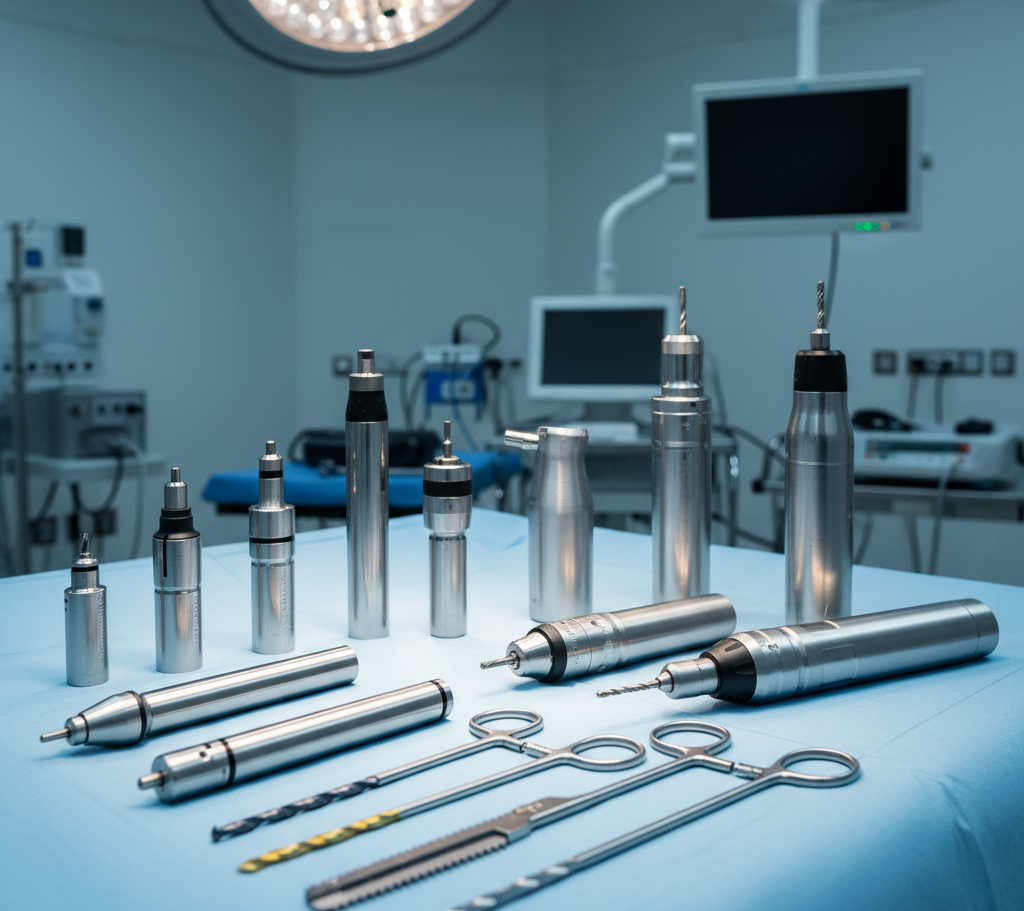Power surgical instruments are advanced medical devices driven by electrical, pneumatic, or battery-based power systems to support surgeons in performing high-precision surgical tasks with greater efficiency and control. These powered devices are commonly used in orthopedics, neurosurgery, ENT, cardiovascular surgery, trauma care, and minimally invasive procedures.
Unlike traditional manual tools, power surgical instruments increase accuracy, reduce procedure time, and minimize surgeon fatigue, which ultimately improves patient outcomes.
This in-depth guide explains what power surgical instruments are, how they work, their applications, advantages, safety protocols, and buying considerations, making it ideal for hospitals, medical distributors, or surgical trainees.
H2: What Are Power Surgical Instruments?
Power surgical instruments are surgical tools that utilize an external power source — such as electric motors, pneumatic (air) systems, or rechargeable batteries — to perform cutting, drilling, sawing, reaming, shaping, and fixation tasks during surgery.
These tools provide mechanical power, allowing surgeons to perform complex procedures faster and with improved precision.
H2: Types of Power Surgical Instruments
Power surgical instruments are classified based on their energy source and surgical application.
H3: 1. By Power Source
| Type | Power Supply | Usage |
|---|---|---|
| Electric Powered | Corded or console powered | Neurosurgery, ENT |
| Battery Powered | Rechargeable batteries | Orthopedic, trauma |
| Pneumatic Powered | Compressed air | Heavy-duty bone drilling & sawing |
H3: 2. By Surgical Specialty
| Specialty | Power Tools Used |
|---|---|
| Orthopedic Surgery | Bone saws, reamers, drills |
| Neurosurgery | High-speed micro drills |
| ENT Surgery | Microdebriders |
| Dental/Maxillofacial | Micro handpieces |
| Trauma Surgery | External fixation & bone cutting |
| Spine Surgery | High-torque drills |
H2: Common Examples of Power Surgical Instruments
| Instrument | Application | Function |
|---|---|---|
| Surgical Drill | Orthopedics, spine | Creates holes in bone |
| Oscillating Saw | Joint replacement | Cuts bone precisely |
| Microdebrider | ENT surgery | Tissue removal with suction |
| Reamer | Hip & joint surgery | Shapes bone cavities |
| High-Speed Burr | Neurosurgery | Precise cranial shaping |
| Cranial Perforator | Brain surgery | Controlled skull perforation |
H2: How Power Surgical Instruments Work
These instruments operate through a motorized mechanism that converts electrical, pneumatic, or battery energy into rotational or oscillating motion. This allows surgeons to:
- Cut bone faster
- Shape anatomical structures precisely
- Reduce manual effort
- Perform minimally invasive procedures
H2: Benefits of Power Surgical Instruments
H3: 1. Precision and Control
Powered tools provide controlled cutting, reducing surgical trauma.
H3: 2. Reduced Operating Time
Procedures are completed faster compared to manual instruments.
H3: 3. Less Surgeon Fatigue
Motor-driven movement lowers physical strain on surgeons.
H3: 4. Better Clinical Outcomes
More accurate cuts lead to improved healing and alignment.
H2: Applications of Powered Surgical Instruments
H3: Orthopedic and Trauma Surgery
Used for bone cutting, screw placement, joint replacement, arthroplasty.
H3: Neurosurgery
Micro drills help in delicate cranial procedures.
H3: ENT Surgery
Microdebriders remove soft tissue safely and precisely.
H3: Dental and Oral-Maxillofacial Surgery
Used for shaping bone and tooth extraction.
H2: Materials Used in Power Surgical Instruments
High-grade materials are used to ensure performance and sterility:
- Medical-grade stainless steel
- Titanium alloy
- High-density polymers
- Tungsten carbide tips
H2: Cleaning and Sterilization of Power Surgical Instruments
Unlike traditional instruments, powered tools require special care, especially when electrical components are involved.
H3: Cleaning Steps
- Pre-clean immediately after use
- Detach removable parts
- Use neutral pH enzymatic detergents
- Avoid full immersion of motorized handpieces unless permitted
- Dry thoroughly before sterilization
H3: Sterilization Methods
| Method | Best For |
|---|---|
| Steam Autoclave | Most external surfaces |
| Low-Temp Plasma (H₂O₂) | Heat-sensitive parts |
| Chemical Sterilization | Delicate motors |
H2: Safety Considerations
| Safety Factor | Why It Matters |
|---|---|
| Torque control | Prevents bone damage |
| Speed regulation | Avoids overheating |
| Ergonomic grip | Reduces surgeon strain |
| Compatibility | Must match accessories |
| Maintenance | Extends tool lifespan |
H2: Leading Manufacturers of Power Surgical Instruments
Some well-known global brands include:
- Medtronic
- Stryker
- Zimmer Biomet
- DePuy Synthes
- Aesculap (B. Braun)
- Conmed
H2: Buying Considerations for Hospitals & Clinics
When investing in power surgical instruments, consider:
- Speed and torque performance
- Ergonomic design
- Battery life (for cordless tools)
- Durability and material
- Compatibility with accessories
- Warranty and service support
H2: Difference Between Manual and Power Surgical Instruments
| Feature | Manual Instruments | Power Instruments |
|---|---|---|
| Speed | Slow | Fast |
| Precision | Moderate | High |
| Fatigue | High | Low |
| Efficiency | Lower | Higher |
| Cost | Lower | Higher (technology-based) |
H2: Future of Powered Surgical Instruments
The future trend is toward robotic integration, AI-assisted navigation, and wireless battery-powered designs with greater sterility and energy efficiency. Hospitals are increasingly moving toward equipment that supports minimally invasive and robotic-assisted surgery.
Conclusion
Power surgical instruments have transformed the way modern surgery is performed. Their precision, efficiency, and ergonomic benefits make them essential in orthopedic, neurological, ENT, trauma, and minimally invasive surgery. As technology continues to evolve, powered tools are expected to further improve surgical outcomes, reduce patient recovery time, and support advanced surgical techniques.

